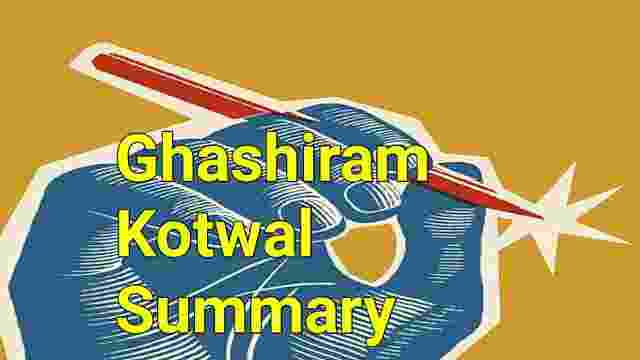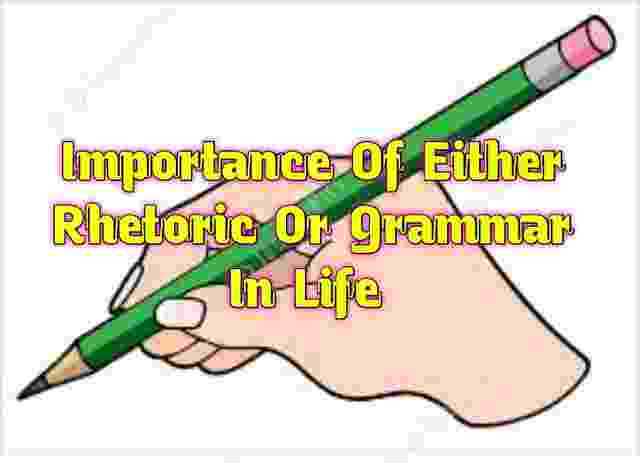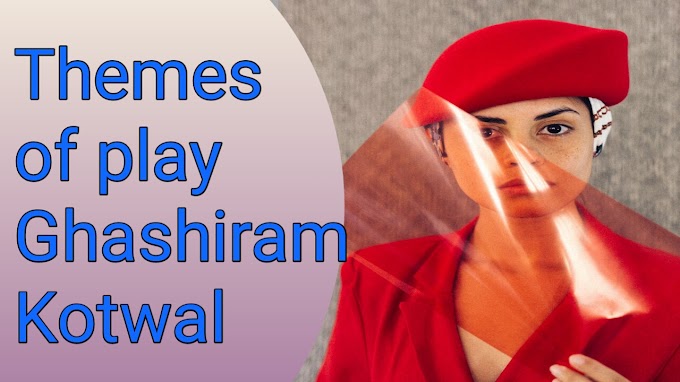Theme Of Ghashiram Kotwal
Theme Of Ghashiram Kotwal : A theme is that the subject of (he play - the read and message that the author communicates.
A play could have over one theme and it's quite potential to own a main theme and several other sub-themes that originate from it.
What then is that the main theme in Ghashiram Kotwal ?
The temperament clash between the Nana and Ghashiram could seem to be the theme at the surface level however we all know that Tendulkar has examined the link between faith, caste. sex and violence to reveal the structures of power that maintain the established order.
As we've detected, Tendulkar regarding|worries|is bothered} about the politics of power and its numerous implications. per Saimik Bandhopadliyay, 'In Ghashiram, power is outlined 'horizontally' in terms people|of people} against individuals from humiliation, to revenge in assertion, to ultimate victimization.. ...' (Ghashiram Kotwal, Seagull, Calcutta, 1984, p.v.)
Can we believe this?
it'd appear on one level that a personal is honeycombed against another. However, at another level it's clear that the forces of state and society stay supreme even when people have perished. as an example, Ghashiram, associate innocent newcomer to Poona is unjustly suspect of stealing and is overwhelmed up by the Poona Brahmans.
This incident makes Ghashiram vow to revenge himself on them.
It is fascinating that Ghashiram, himself could be a Brahmin, has turned against his different brethren.the chance for return with the Brahmans presents itself once the sexy Chief Minister of the Peshwa. The ageing Nana Phadnavis needs his stunning girl Lalita Hindu deity.
Then begins the sport of power during which Hindu deity is formed a pawn and sacrificed to Nana's lust.Ghashiram is formed the Kotwal of Poona.
This serves 2 purposes:
one, it provides Ghashiram the chance to require his revenge and unleash terror on the folks of Poona and 2, it permits Nana to own his cake and eat it too.
He has Hindu deity on the one hand and on the opposite his own tyranny is obscured by Ghashiram's cruelty.
it's clear even at this stage that the deal is associate unfair one because the profit lies in the main on the facet of Nana.
and eventually, Nana sacrifices Ghashiram to the bloody-minded crowds while not the slightest rue or regret and at the top of the play we discover that he himself continues to thrive.
Who is absolutely powerful; Nana or Ghashiram ?
We notice that the facility is simply deputed in Ghashiram UN agency doesn't notice this and begins to mistake it for real power.
When he loses Lalita Hindu deity and his game is up, lie realizes his error and also the reality of his position.
It isNana's misdeeds that are "credited to his account".
It appears then that power conceals itself behind its agents and continues to thrive undisputed.
Does the facility rest with Nana?
It would appear thus however even Nana decision be summoned at any moment by the Peshwa.
The Peshwa himself could be a image of power at intervals the context of social organization society.
Thus the facility unconditional in him is underpinned by the social set-up that functions on the premise of maintaining the established order. The king or the Peshwa during this case has the facility by virtue of the Divine Right. His position is maintained by numerous state apparatuses just like the army, the police, non secular and social establishment, etc.
Here the facility is delegated within the Nana UN agency more deputes it to Ghashirarn by creating him the Kotwal UN agency then operates through a force.
Thus, there's an entire hierarchy of power positions.
It appears then that it's a personal against a personal. as an example, if an individual is overwhelmed up by the police. he will see the evil face of that exact law officer alone.
He doesn't notice that the law officer is backed by the force that once more is maintained by a selected state.
The state itself functions per a particular ideology. A society structured in such some way ensures that power is maintained and supported by such hierarchies.
The attention is targeted on people UN agency ar transpire as culprits.
But the $64000 perpetrator, the social set-up continues undisputed as individual is honeycombed against individual and albeit Ghashirams ar created and destroyed, society remains unchanged.
The eye is amused from the $64000 downside that still remains untouched and Tendulkar's play terribly subtly makes U.S.A. place confidence in and analyse this development.
We have seen however power operates a lot of overtly through violence and oppression.
At a refined level, it functions through such social attitudes that facilitate in maintaining hierarchies and concealing the $64000 supply of power that is delegated in agents like Ghashiram UN agency are victims of that very same power.Religion and sex are used because the ways of power.
Religion :
While the military and police ar utilized by the state to keep up management at intervals societies, there ar different subtler ways that are used.
as an example, religion.
Most religions tell U.S.A. to show the opposite cheek if we tend to ar hit. This prevents U.S.A. from reacting against tyranny and injustice.
Once we imbibe these values throughout childhood, initial within the family. then within the faculty and eventually in society at massive, they become thus deeply established in U.S.A. that they are doing not permit U.S.A. to challenge or modification our social state of affairs.
Such values ar imparted to U.S.A. thus subtly that we tend to don't question if they're right or wrong.
Take the case of Ghashiram Kotwal.
The play begins with a spiritual hymn and also the in style gods dance on stage.
This sets the context against that the drama unfolds itself .
. The Brahmans visit Bavannakhani to ascertain the dance ladies and say they're going 'to the temple' to relinquish a sermon oil 'Vishwamitra and Menaka'. They justify their degradation by comparison Bavannakhani to holy Mathura.
The 'abhanga' or pious song is commonly sung with the 'lavani'or love song in his play. Scenes of violence arid cruelty ar alternated with pious songs. once Nana tries to seduce Hindu deity ahead of the sculpture of the holy Ganesa, he merely dismisses her fears saying: that each one holy Ganapati? The maker of Good? Look, he has 2 wives. One on this facet, one on it side'.
more on within the play, once Hindu deity is dead and also the agitated Ghashiram confronts Nana and accuses him of his daughter's death, the latter reassures him:
'He - the present - He makes everything happen ...... we tend to ar just instruments .......' He then urges him to ' forget what is going on. All merges into the Ganga. 'Thou shalt not grieve over what's gone. The Vedas have same that' (P 44). "
Don't you're thinking that here could be a case of the devil citing scriptures to suit his purpose?
faith then becomes a helpful alibi in covering people's misdeeds.
By invoking faith, all types of evils ar glossed and even holy. Rituals ar inspired to fill the pockets of the greedy Brahmans. what is more their position because the 'twice born' is strengthened by the prevalence of the class structure.
Caste:
Alorigwith faith, caste is additionally a significant consider the play.
Is it a touch upon the degradation of the Brahmans?
When the play was initial performed it had been prohibited for being anti-Brahman and for worry of there being a revolt within the audience.
Is it very meant to reveal Brahmans, their corruption and ethical degradation?
According to the author he was a lot of inquisitive about 'the emergence, the expansion and also the inevitable finish of the Ghashiram .....
The degradation of the category in power (the Brahmans, incidentally, throughout the amount that I had to depict) conjointly was incidental although not accidental.Caste is employed as associate instrument of power.
The Sutradhar reports that per Ghashiram 'to eat with a lower caste person could be a crime' (p. 26). To have sex a 'Maliar woman' (a lower caste among the untouchables) is additionally thought-about against the law. On the opposite hand, the Bralimans, don't have any hesitation in chasing and irritating a white European for cash.
This shows that race and color represent the next position within the social hierarchy. and also the white European ranks over the privileged Brahman UN agency is feasted and showered with gifts within the Peshwa's Poona.
Tendulkar has portrayed the hypocrisy of the Brahmans, their vanity, autarchy and their, dissolute and adulterous behaviour. instead of being recognisable by their sensible deeds and noble behaviour, the Brahmans ar notable by their 'shaven head', 'holy thread' and 'pious look'. it's this pious look that conceals their petty deeds.
Nana himself a Brahman is marrying for the seventh time to not mention his lusting when various young ladies, Lalita Hindu deity among them.
although jam-packed with revenge and emotion for the Brahmans, Ghashiram is himself a Brahman.
And his conduct in bartering his daughter's virtue for the dubious distinction of changing into the Kotwal of Poona, will hardly be even and speaks of his inhuman self-seeking similarly as total lack of paternal sentiment and sensitivity.
The full image of the Brahmans that emerges from this play is one in every of hypocrisy. double standards, self-indulgence and ethical degradation. It exposes the rottenness of the caste-system that privileges an individual on the premise of birth instead of benefit and maintains the rigid hierarchy to manage and suppress persons.
Sexuality :
Women too, as we've seen, became a pawn within the power game. if truth be told there's an in depth nexus between sex and power.
Consider, as an example, Nana's statement with relevance Lalita Gauri: 'Our grandeur's gone if she's not had' .
A man's self-image, identity and masculinity is determinable solely, it seems. in reference to the conquest and oppression of ladies. there's an in depth affiliation between sex and faith as lavanis (love song) and abhangas (devotional song) ar sung at the revelries in Bavannakhani that is likened to Mathura and also the titillating dances to Krishan Lila.
The garb of faith helps to justify and whitewash the debaucheries of the Brahman men. Gulabi's tantalizing dances, the Nana's lustful pursuit of Lalita Hindu deity, the undercover meeting of the Brahman mate with a Indian lover, all serve to form associate underlying strain of eroticism throughout the play.












0 Comments